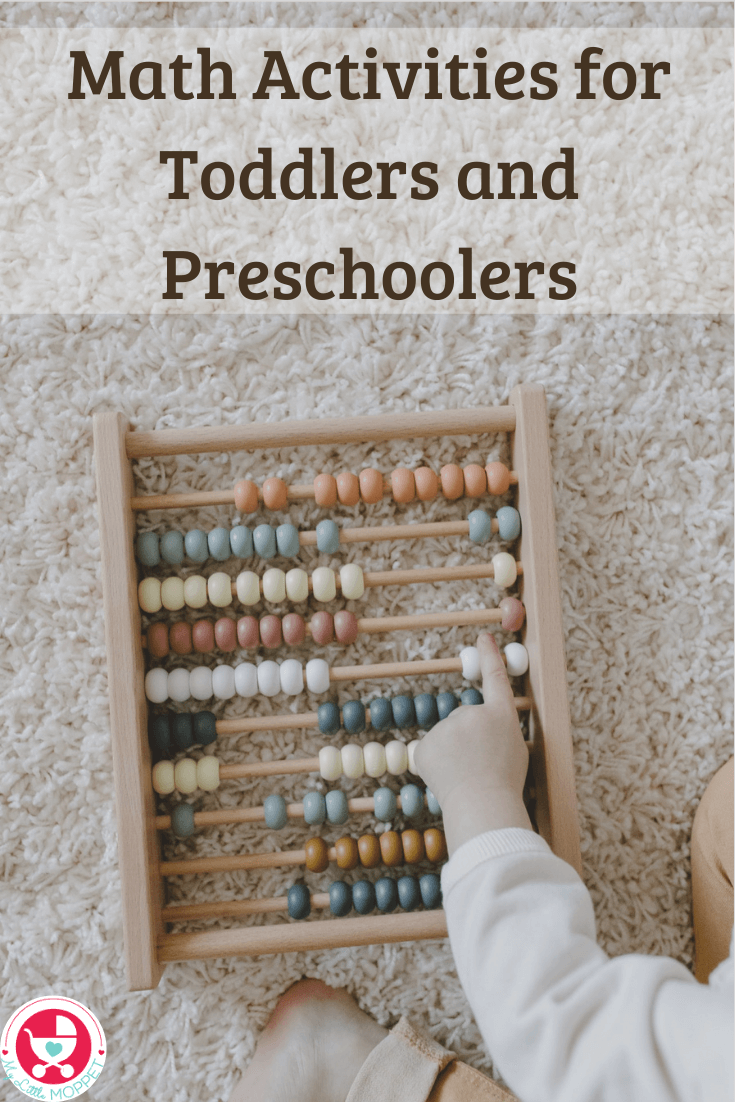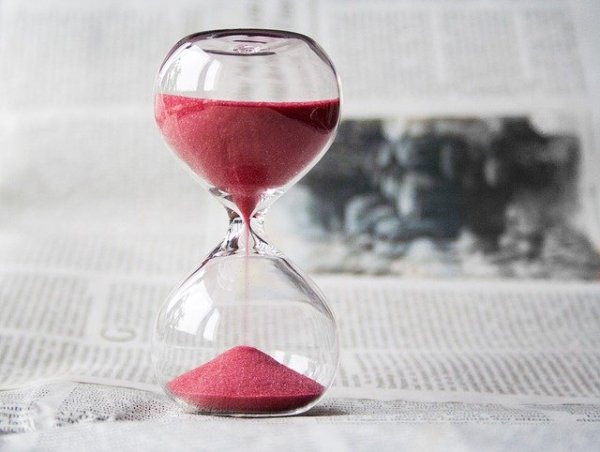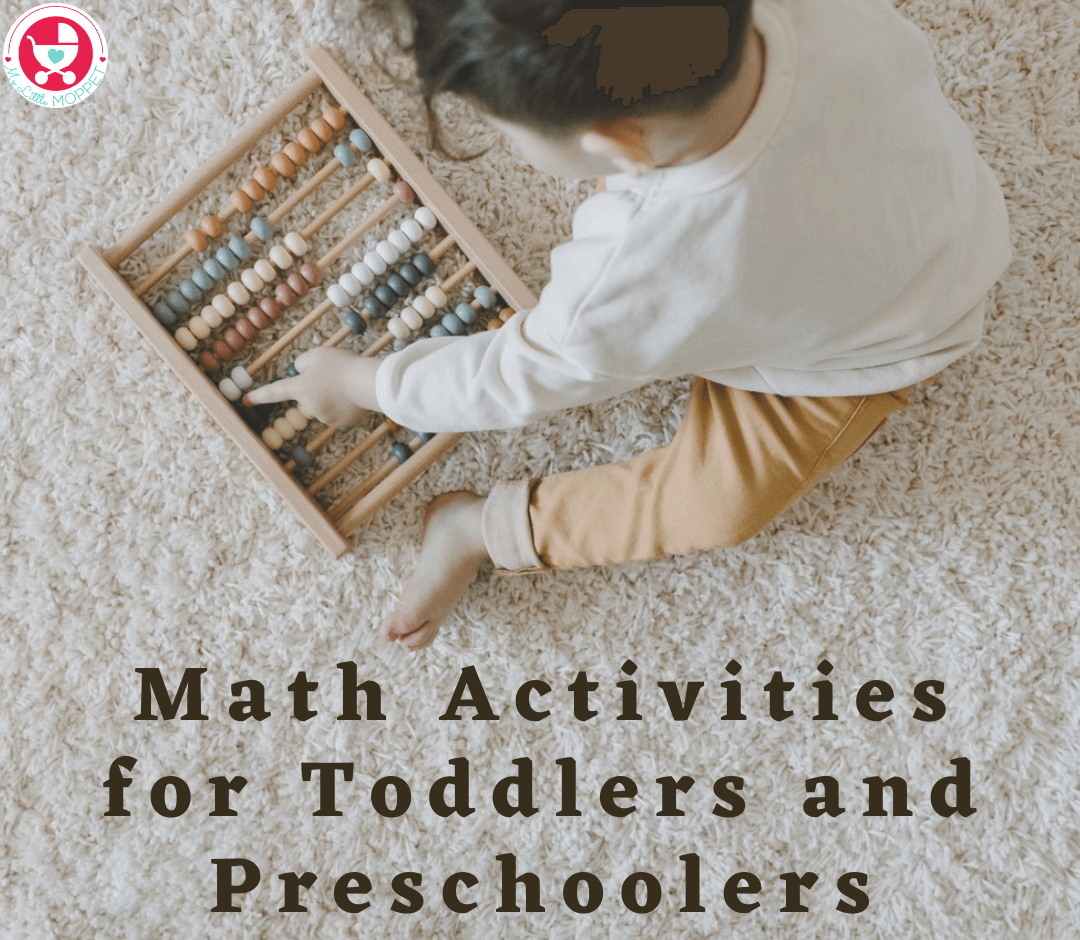These simple Math Activities for Toddlers and Preschoolers are perfect for developing early Math skills, which are crucial for future academic success.
When most of us think of Math, we have horrible throwbacks to undone homework, problems that seem impossible to solve, and dreaded exams. Few of us associate Math as something enjoyable and exciting, and a lot of it has to do with our conditioning.
While most parents put a lot of importance on early literacy with books and reading, not many realize the importance of early math skills, and this is a phenomenon seen worldwide. One study found that if young kids spent six hours at preschool, they spent only 58 seconds in developing early math skills. This needs to change.
Why are early math skills important?
Early math skills aren’t just important for understanding numbers; they are crucial for problem solving skills and logical and analytical thinking. An article in Developmental Psychology states that early math skills are more important than reading skills in ensuring future academic success. When kids spend time in mathematical learning, their reading skills and concentration goes up automatically.
Here are the math skills that play the biggest role in good problem solving skills and logical reasoning in the school years:
1. Counting and cardinality – This is regarding basic counting, identification of numbers and understanding that number relates to the quantity of items in a group. Children first learn to count forward and later, backward.
2. Comparison – Comparison helps kids identify which item is bigger or smaller, and to differentiate between more and less. They should be able to do this in terms of numbers and things that can’t be counted.
3. Patterns – Patterns can refer to any sequence that repeats in a certain logical manner. This is important in helping kids make connections and predict outcomes of what happens next.
4. Shapes – What later becomes geometry is the study of shapes in early childhood, and this also includes how different shapes fit against and within each other.
5. Measurement – Measuring various aspects of an item, like weight, height or volume is an important part of early math skills, and for very young children it may start with comparison of less and more.
6. Estimation – Estimation is a skill that enables a child to make a well reasoned guess about the size or quantity of an item. This also begins with being able to compare things and differentiate between less an more.
7. Problem solving – Early math skills don’t just teach how to solve a problem – it also teaches kids that there can be multiple ways around a problem, and we can choose the one that is the best.
Early Math Skills according to Age
Babies (0–12 months)
- Understand cause and effect, like shaking a rattle makes noise
- Classifying, like knowing which toys make noise and which don’t
- Prediction – being able to tell what’s going to happen based on cues like running water, mother taking out the breast
- Comparisons, for instance they realize that they’re small and Mom is bigger
Toddlers (1-2 years)
- Understand that numbers refer to the quantity of an item
- Start filling and emptying cups and containers
- Match shapes like circles and triangles
- Recite a few numbers, not necessarily in the right order
- Recognize basic patterns
- Sort items based on type
Preschoolers (3-4 years)
- Identify shapes in everyday life, like round plates or square crackers
- Compare items based on size
- Sort items based on color, shape or size
- Count up to 20
- Identify numbers by sight
- Put simple puzzles together
- Predict outcomes for actions
After this age, kids are usually at school in kindergarten, and formal education takes over. However, with the pandemic on and kids stuck at home, it is up to us parents to make an effort to help our children develop these crucial early math skills. The best way for kids to learn any skill, not just math, is through play. Here are some simple math activities for toddlers, some of which you can also start when your little one is still a baby. As with everything good, the earlier, the better!
1. Sensory Play
Sensory play has several benefits for very young kids, and it can be used in a multitude of ways. Beginners to sensory bins can simply touch and see how everything in the bin feels when their hands go over them. As they get accustomed to it, they can use scoops and cups to fill, empty and refill their containers to get an idea about measurement, quantity and to be able to estimate how much will fill in a cup.
For older toddlers, you can also give them weight scales so they can try to balance both sides – this is a great way to learn comparison and measurement.
2. Interactive Books
This is something you can use even with little babies. There are many books out there with flaps that lift and reveal something underneath, and these teach spatial language – under, over, behind, next etc. These books often integrate many other concepts like shapes and sizes in the process.
Another kind of interactive book is the one which encourages you to perform an action. For instance, Counting Kisses encourages you to count the kisses and cuddles you shower on your little one – can’t think of a more adorable way to learn Math!
3. Shape Sorters
Shape sorters are great first toys for babies and toddlers. They obviously teach kids about different shapes, but they also have holes in the same shapes and kids will have to try and find which peg goes into which hole. Playing with shape sorters This also encourages spatial skills and reinforces the differences between shapes.
Research shows that kids who learn shapes and develop spatial skills in early childhood have better IQ and score better in math and even writing. Shape sorters also double up as building blocks in some cases, like this set. They are brightly colored and encourage kids to learn primary colors.
Everyone has some cardboard at home, from cereal boxes or online order cartons. You can put this cardboard to good use by making this simple cardboard shapes activity from My Bored Toddler. Simply Cut out different shapes from cardboard and paint them if you like. Then hand your child the shapes and let them put them together to create any form or image they like.
Another way to use these shapes is to create a pattern. Start with something very simple: square-circle-square-circle. Let your child continue the pattern and you can later take it to the next level by introducing a triangle in the mix. This is ideal for children who do not put everything in their mouth, since cardboard isn’t durable enough to withstand chewing.
5. Sorting Activities
Being able to see how things are different from each other and how some things are similar to each other is an important part of early math skills. Hand kids a few tubs or baskets and encourage them to sort their toys. Start with an easy sort, like all red toys in this basket, or all cars in that box. As kids learn shapes, you can ask them to sort circle shapes in one and square ones in another.
You can also encourage sorting as you go about your daily chores. For instance, when doing laundry, ask them to sort all shirts in one pile and pants in another. Or when you’re folding, you can ask them to put all the socks in one pile, and later, they can try matching the socks to each other.
6. Building Blocks
Building blocks are probably the one toy that can be used by kids of all ages, from infancy to well, the teen years and beyond, if adult Lego fans are anything to go by! There are all kinds of blocks, like plain wooden blocks, colored plastic ones, or blocks that interlock, like Lego.
Building blocks are excellent to boost spatial skills and it teaches a host of other math skills too, like balance and symmetry. Kids learn to see how tall they can make a tower before it falls off. They can see that a sturdier base makes it easier to make a taller tower. It also helps them understand spatial language like over, under, behind etc. In fact, research says that playing with Lego during early childhood can be a factor for better success in math at the high school.
7. Pattern Play
Understanding patterns is an important early math skill for kids to learn, and they also learn more advanced patterns in school. A pattern is just a recurring sequence, and it helps kids learn to make connections and predict what comes next. You can start out by using whatever you have at home to create a pattern – dry pasta, toy cars, animals, and of course, building blocks.
Start really simple, like a row of alternating blocks in different colors. Then introduce a third color or maybe you can alternate a toy car and a toy animal. There are literally a zillion ways to do this, and you can adjust the complexity based on the age of your child.
The Best Ideas for Kids has a great activity that you can put together with a cardboard box and cardboard tubes. It’s a very simple toy and kids of any age can have fun with it. Very young children or babies can just enjoy dropping things in at one end and seeing it come out the other, reinforcing the concept of cause and effect.
Older kids can get a lot more out of this activity. You can use pom poms and count and drop a specific number down the rolls. As kids start learning mathematical operations, this serves to understand the concept of addition, so kids can see how things that roll down either chute end up in the sum at the bottom.
Another fun activity for toddlers and preschoolers is this one from Toddler at Play, which gets interesting as clothespins enter the picture. You can use wooden clothes pegs for this, and paint them in any color you like. Kids can also help painting the pegs.
There are many ways to use these cards. Kids can match the color of the pegs to the color of the number on the cards. Older kids who can identify numbers can count pegs and fix the appropriate number on the card. This is also a fun fine motor activity to strengthen hand muscles of little kids.
10. Cooking
The kitchen is a place where kids can learn all kinds of skills, and math is one of them. Young children can learn about simple measurement, like 1 cup, 2 cups. This is also a more practical implementation of the filling and pouring kids do otherwise. Kids can also count things, like eggs, or tomatoes.
Older kids can also understand different kinds of measures, like cups and spoons, and also read numbers on the weighing scale. The skills don’t end in the kitchen; kids can also help lay out the table, count how many people are there and how many plates are needed.
11. Observation Walk
If you look closely, there are many ways to enhance early math skills. To make it more intentional, go on an observation walk, either at home or outdoors. Spot trees and see how one is bigger than the other. You can count things you see – two cats, one dog. You can also use spatial language, by observing a house behind a gate or a cat on top of a fence.
As kids get older, you can spot shapes and colors, like on road signs. You can also count the steps it takes to reach your front door. If you visit the supermarket, there are many more opportunities to count, compare and measure.
12. Pretend Play
Pretend play fosters several important skills and is also crucial for emotional and social development in children. There are many ways to do this, but usually a play kitchen set is all you need. Kids can pretend to have a cafe/bakery/ice cream shop and you can be a customer and the games can begin!
Children can decide on what to serve, and you can order one or two coffees. You can also cut out cardboard coins, and pay accordingly for each dish served. It also builds early concepts about money. You can also use cardboard to create your own pretend play food, using shapes like square for bread slices, circles for fried eggs or cookies. For older kids, you can use pizza parts to learn the basics of fractions.
13. Board Games
While there are complex games like Monopoly and chess that are great to enhance math skills like logic, reasoning and strategy, you don’t need these for developing early math skills in kids. Simple games like Snakes and Ladders are just as effective. Even games that involve a lot of counting, like Ludo, are perfect for preschoolers.
Besides these counting games, memory games are also an excellent way to identify similarities, improve memory and match items based on the similarities. You can either buy memory games online or make your own set by using free printables.
14. Physical Activities with Math
While board games are great to enhance math skills, you can also include some physical activity while learning math skills. Jump rope is an excellent way to stay active by jumping and counting the jumps. Little kids can start out by simply clapping a certain number of times, or in sync with number nursery rhymes.
As kids grow older, let them have fun with games like hopscotch, which is great for counting numbers and learning to balance as well. A dart board is also fun, especially if you’re keeping score. You can also use dice to create your own fun game with all kinds of fun actions like jumping, bouncing, hopping on one foot etc.
15. Timed Activities
Besides counting and measuring, date and time are also an important part of early math skills. Have a big calendar displayed and let kids come and put a sticker or mark the dates. You can also have those calendars where you have to manually change the date, like this one. Calendars also help to reinforce repeating patterns and routines.
Another way to learn about time is to use a timer. Ask a child to put away his toys and he’ll run, but set a timer and ask him to do it before the timer runs out and he’ll race to finish. It’ll also help kids understand how some tasks take longer than others, and enables them to estimate time for tasks.
Source: https://www.mylittlemoppet.com/math-activities-for-toddlers-and-preschoolers/
The content is owned by Fabida Abdulla. Visit site here for other valuable articles.






















No comments:
Post a Comment